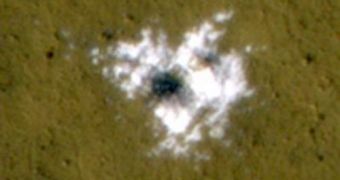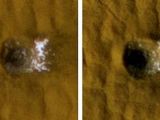According to a recent series of investigations that analyzed the surface of the Red Planet halfway between the North Pole and its equator, water ice may exist directly under the first layers of soil. Also, experts have found, it may be that these reserves are as much as 99 percent pure, and free of any contaminants. The sub-surface water can mostly be found inside recent meteorite craters, a team of scientists from the University of Arizona reveals.
“We knew there was ice below the surface at high latitudes of Mars, but we find that it extends far closer to the equator than you would think, based on Mars' climate today. The other surprising discovery is that ice exposed at the bottom of these meteorite impact craters is so pure. The thinking before was that ice accumulates below the surface between soil grains, so there would be a 50-50 mix of dirt and ice. We were able to figure out, given how long it took that ice to fade from view, that the mixture is about one percent dirt and 99 percent ice,” UA expert Shane Byrne says.
He is a member of the team that manages the High Resolution Imaging Science Experiment, or HiRISE, instrument aboard the American space agency's Mars Reconnaissance Orbiter (MRO). The spacecraft was able to use several of its instruments in a specific succession that revealed water ice exposed inside “new” craters, ranging from 1.5 feet to eight feet in depth. The find was made at five Martian sites, so the chance of this being an anomaly, rather than the norm, is fairly slim.
“We saw something very unusual when we followed up on the first of these impact craters, and that was this bright blue material poking up from the bottom of the crater. It looked a lot like water ice. And sure enough, when we started monitoring this material, it faded away like you'd expect water ice to fade, because water ice is unstable on Mars' surface and turns directly into water vapor in the atmosphere,” Byrne adds. A few days later, the team used the Compact Reconnaissance Imaging Spectrometer for Mars (CRISM) instrument, which detected the spectral signature of water ice too.
“All of this had to happen very quickly because 200 days after we first saw the ice, it was gone, it was the color of dirt. If we had taken HiRISE images just a few months later, we wouldn't have noticed anything unusual. This discovery would have just passed us by,” the expert adds. Details of the MRO investigations appear in the September 25th issue of the top journal Science.

 14 DAY TRIAL //
14 DAY TRIAL // 
